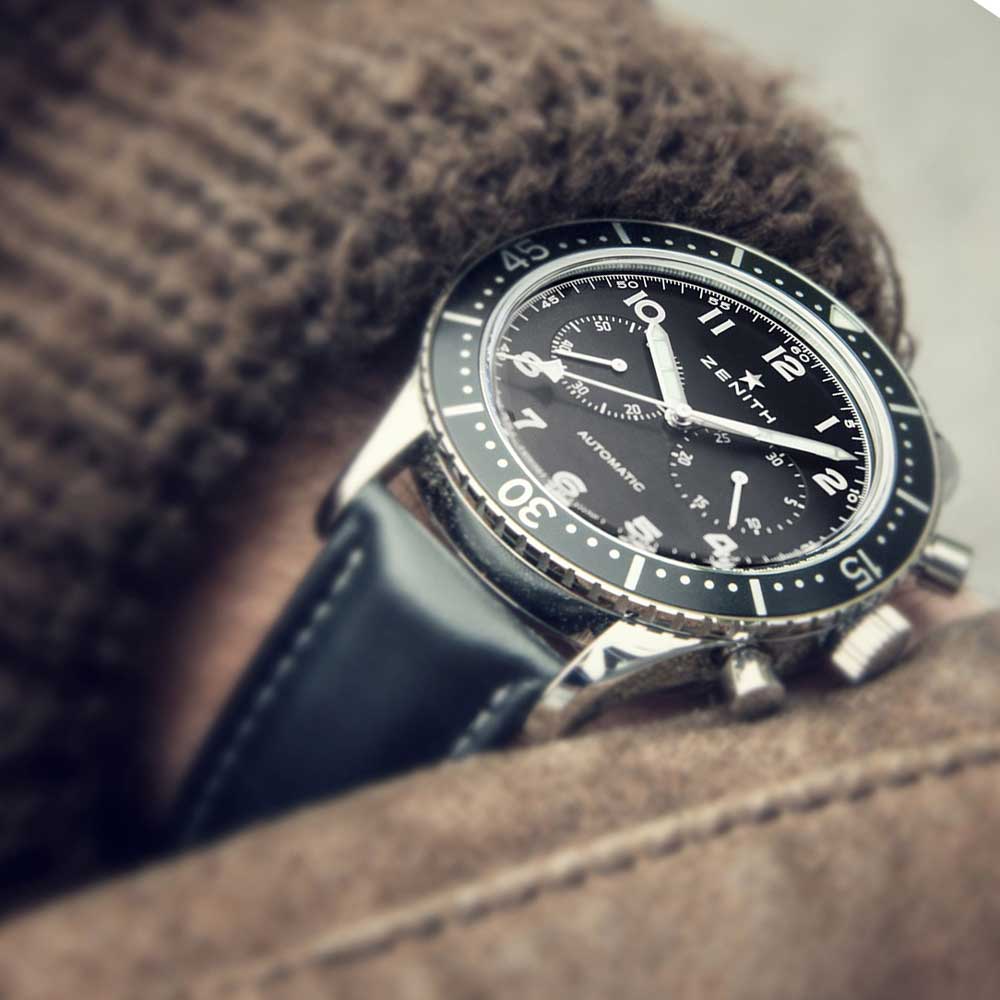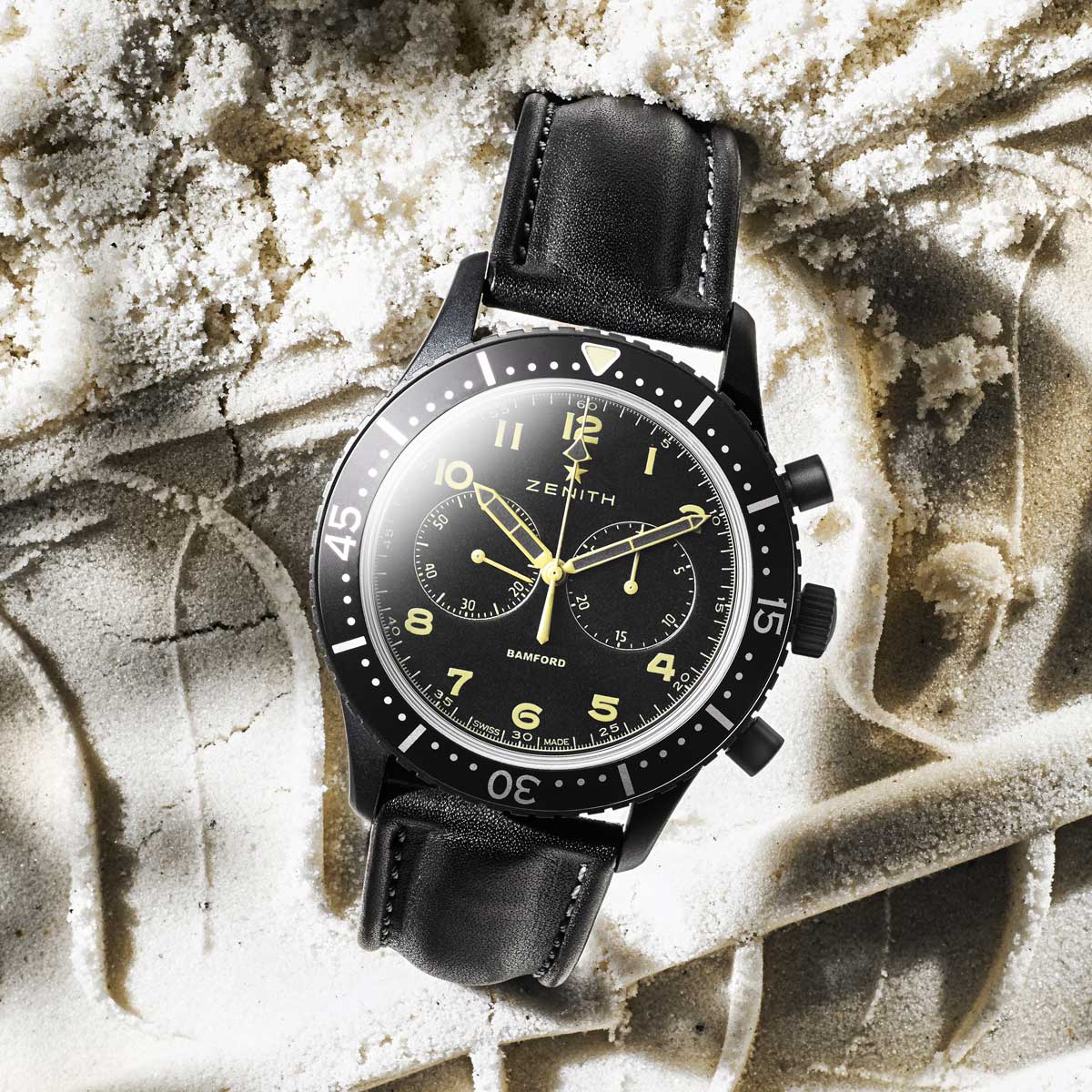Bamford Watch Department
Bamford x Revolution x Huitcinq1988
Bamford Watch Department
Bamford x Revolution x Huitcinq1988
Case in point the lever-locking mechanism of the Panerai Luminor Marina, used to prevent the intrusion of water as Italian frogmen piloted massive, unwieldy, human-guided torpedoes. In the days before GPS, that was not just a distinguishing design element, but a hard-used and tested innovation. The lyre-lugged, two-pusher iconography of the Omega Speedmaster, distinguished in particular by its tachymetric scale emblazoned boldly and audaciously on the bezel (a world’s first) not only renders it the world’s most famous chronograph, but conjures up the extraordinary bravery of the Apollo XIII astronauts using a Speedmaster to angle their crippled spacecraft for safe re-entry. A failing in either their calculations or the watch’s performance would have been fatal. And so too, the A. Cairelli Type 2 Chronograph created for Zenith channels the period cool of Italian helicopter pilots during the mid-1960s.
If you’ve never heard of A. Cairelli, the story goes that it was not only a famous Roman watch retailer, but also a subcontractor for the Italian military. During the 1950s, the Italian air force – the Aeronautica Militare Italia (A.M.I) – ordered the predecessor to the CP2, the CP1, from a company called Leonidas. The CP1 was 39mm in diameter and was fitted with a Valjoux 22 hacking flyback chronograph movement. But by 1960 it was deemed too small to provide adequate visibility in the cockpit. The Italian military reached out to A. Cairelli for an enhanced pilot’s watch and selected Zenith as the supplier for this prestigious project.
But it was the iconography of the watch – the form-follows-function pragmatism endowed with a healthy dose of Italian braggadocio – that created such a winning formula. The case was tripartite, with a separate bezel, case and caseback. In deference to the enduring peace throughout Europe the case was high polished, clearly articulating that it was most likely not to be worn when engaging the enemy. The large Dauphine hands were fitted with multi-sectional pieces of luminous material, while the bevelled, almost Art Deco, luminous-tipped chronograph seconds hand is one of the most recognizable symbols in vintage watch lore. The matte black dial was bestowed with truly charming luminous Arabic markers that evinced a flourish of Latin font design élan. The total package was just so damnably good looking.
The Comeback Kid
Cut to 2016 when Zenith demonstrated their understanding of the booming fascination with all things vintage and took it upon themselves to relaunch the fabled Type 2, albeit with a few changes. The first is that the dial no longer bears the A. Cairelli name, as there is a trademark issue related to this. Instead the watch is referred to in Zenith speak as the Cronometro Tipo 2, the Italian moniker a charming reference to the timepiece’s lineage traced to the land of Julius Cesar and Bernini. Inside the case of the Tipo 2, Zenith has replaced the old workhorse Martel calibre with its own 5 Hz, integrated automatic column-wheel movement, the legendary El Primero. And, while some might feel the addition of an automatic movement compromises the faithfulness to the vintage watch, I am very much of the opinion that the automatic calibre supremely enhances function and reliability. In addition, I am near evangelical in my feeling that there could be no better movement in any Zenith watch that the fabled El Primero, the world’s first automatic chronograph.
The El Primero was designed from the ground up to be an integrated automatic chronograph movement, which means the movement was designed as one cohesive unit. This stands in marked contrast to the other automatic chronograph launched in 1969 – by Breitling, Heuer and others – the Caliber 11, which mates a chronograph module to a pre-existing calibre. My issue is that modular chronographs are parasitical in nature, consuming power from a movement never designed to satisfy the additional consumption of a chronograph. The El Primero was a proper haut de gamme chronograph with adequate power to feed both the normal gear train and a chronograph train. In addition, it featured a column wheel, which, say what you like, to me is still the sign of a refined movement. And most incredibly it beat at 5 Hz, the first for a movement produced in true quantity and the first time the public had been offered a chronograph that could divide time to 1/10th of a second.

The 2016 re-issued Zenith Pilot Cronometro Tipo CP-2
Enter George Bamford
But when I saw the stunning 1,000-piece limited re-edition watch launched by Zenith I instantly began to reflect on the classic iconography and how this could be a platform for an ultra-cool concept watch. It should be said that I was not alone in this. Throughout 2017 the ultimate watch customizer, Bamford Watch Department (BWD), transformed the Tipo 2 into a canvas for its signature blacked-out urban stealth watch.

Bamford X Zenith Tipo CP-2 Green
But of all the timepieces that Bamford creates it is in particular when he turns his attention to the Tipo 2 that a certain electrifying magic starts to happen. Says Bamford: “The basic canvas of this watch is so strong, there is already something so compellingly heroic about it. And so, it wasn’t so much about printing the Bamford identity on this watch but allowing a certain character already imbedded within the watches to emerge full force.”
A New Partnership
Soon the conversation centered around a collaboration between Bamford and Revolution focused precisely on the ultimate execution of the Zenith Cronometro Tipo 2 refracted through his imagination. According to Bamford: “Immediately I thought of a stealth black case, and a similar black dial and bezel characterized by two colorways. The first is a military green, but with a touch of urban neon. The second is the color of the sky at twilight but again with a little extra visually operatic chromatic character for more impact. Then I thought it would be interesting to offer the Revolution reader different ways to configure his watch. The first relates to dial texture, where the customer has three options: the dial can be plain; it can have the centre section emblazoned with our signature lozenge-shaped decoration that brings to mind the grill of air induction scoops of performance cars, or a kind of sinister reptilian scale; or you can also choose to have the decoration across the entire dial. Then you can select whether or not you wish the Arabic markers to receive a sort of highlight around them for added drama. And finally, you can select to have the markers on the bezel in the same color – either all the markers or just the key ones.” That way each watch created by BWD for Revolution has its own unique character.
The final touch to the Bamford x Revolution watches is the strap, each of which is individually handcrafted by an artisanal company named Huitcinq1988 helmed by Federico de Peppo. Each colorway, military green and twilight blue has two strap options, both are exotic skin and configured as NATO straps with matching PVD steel ring keepers, though if you have any other requests we are certain we can accommodate them.










